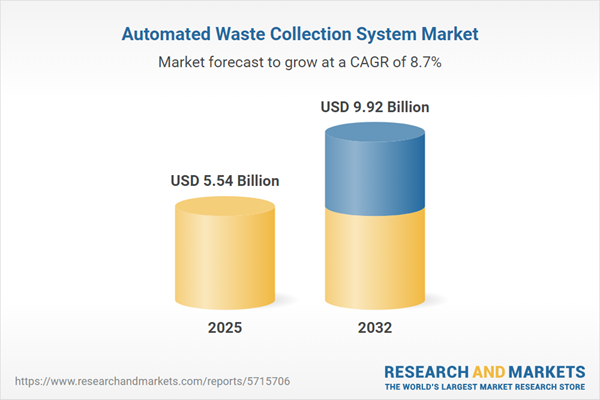Speak directly to the analyst to clarify any post sales queries you may have.
The automated waste collection system market offers senior decision-makers a robust pathway to enhance operational efficiency, support sustainability objectives, and maintain alignment with changing compliance requirements. Leveraging integrated technology and analytics, automated waste systems deliver measurable value and resilience for organizations addressing waste management challenges.
Market Snapshot: Automated Waste Collection System Market
Driven by intensified urbanization, regulatory developments, and demand for smarter waste management approaches, the automated waste collection system market is experiencing steady growth. Valued at USD 5.09 billion and advancing with a CAGR of 8.68%, the market is projected to reach USD 9.92 billion by 2032, signaling strong momentum and increasing sector investment. Adoption is accelerated by regulatory drivers, sustainability priorities, and advanced analytical capabilities. Senior leaders depend on this market intelligence to streamline their operations and align strategies with evolving policy and compliance imperatives.
Scope & Segmentation
- End User: Commercial enterprises are adopting intelligent building solutions to improve efficiency and meet compliance requirements. Industrial sectors deploy automation to facilitate safe and large-volume waste handling. Municipal entities upgrade infrastructure to prioritize public health and well-being. Residential sectors utilize advanced platforms to increase occupant ease and waste handling integration.
- Waste Type: Solutions address hazardous waste management, industrial byproducts, municipal solid waste disposal, and recycling of metals, plastics, glass, and paper for more effective resource recovery.
- System Type: Off-board systems apply pneumatic and vacuum technologies for urban-scale waste transfer. On-board systems incorporate sensors and RFID for automated sorting and responsive routing at point-of-collection, serving varying facility needs.
- Solution Component: IoT platforms are deployed for real-time route optimization, while mechanical subsystems manage precise waste transfer and categorization. Sensor technology streamlines automatic classification. Software offers oversight and analytics. Supporting services include consulting and maintenance, ensuring operational reliability.
- Geographical Coverage: The Americas prioritize smart infrastructure deployments at scale. Asia-Pacific adapts to fast-paced urban growth with swift technology integration. Europe, the Middle East, and Africa focus on tailoring implementations to regional regulations and shifting compliance landscapes.
- Key Companies: Industry development is supported by Envac AB, ESE World ASA, WallTech Engineering Co., Ltd., Hanwha Environment Co., Ltd., BigBelly Outdoor, Ecube Labs Inc., and CleanRobotics Inc., each advancing specialized product offerings and technical expertise.
Key Takeaways for Senior Decision-Makers
- Advanced sensors and machine learning support greater operational efficiency and help organizations pursue sustainability objectives in diverse waste management settings.
- Automated waste collection systems simplify navigation of regulatory requirements, contributing to increased transparency and compliance for complex organizations.
- Commercial, industrial, and municipal stakeholders each leverage automation for their specific priorities, ranging from responsive operations to large-scale handling and adaptive public services.
- AI and IoT-enabled containers enable predictive maintenance and reliable service delivery, minimizing unplanned downtime and extending system longevity.
- Strategic partnerships, including those between established firms and market entrants, deliver enhanced analytics and support ongoing optimization in both sustainability and system performance.
- Operational agility fosters organizational readiness for regulatory evolution and emerging standards, ensuring waste management investments remain future-proof.
Tariff Impact and Strategic Response
Recent hardware import tariffs in the U.S. have prompted system integrators to revise procurement strategies and favor nearshore sourcing models. Modular hardware designs contribute to greater flexibility and efficiency in deploying automated waste solutions. These adjustments also incentivize software innovation and increase risk mitigation capacity, resulting in improved long-term adaptability across the sector.
Methodology & Data Sources
Insights in this report stem from executive interviews, validated governmental resources, and detailed financial analyses. Each finding is rigorously verified using multi-stage review processes and advanced analytics to ensure the accuracy and relevance for market stakeholders.
Why This Report Matters
- Senior executives acquire a foundational structure for evaluating technology adoption strategies within diverse compliance and sustainability contexts.
- Granular segmentation and analysis of user needs, system features, and regional trends aid well-grounded decision-making for organizations in regulated and high-growth markets.
- Assessment of tariff impacts and supply chain shifts delivers actionable recommendations for procurement planning and bolsters organizational risk management.
Conclusion
Automated waste collection systems empower organizations to advance their sustainability agendas and remain responsive in a dynamic regulatory environment. This analysis supports informed leadership, helping teams align their waste management strategies with ongoing advancements.
Additional Product Information:
- Purchase of this report includes 1 year online access with quarterly updates.
- This report can be updated on request. Please contact our Customer Experience team using the Ask a Question widget on our website.
Table of Contents
3. Executive Summary
4. Market Overview
7. Cumulative Impact of Artificial Intelligence 2025
Companies Mentioned
The companies profiled in this Automated Waste Collection System market report include:- Envac AB
- ESE World ASA
- WallTech Engineering Co., Ltd.
- Hanwha Environment Co., Ltd.
- BigBelly Outdoor, LLC
- Ecube Labs Inc.
- CleanRobotics Inc.
Table Information
| Report Attribute | Details |
|---|---|
| No. of Pages | 184 |
| Published | November 2025 |
| Forecast Period | 2025 - 2032 |
| Estimated Market Value ( USD | $ 5.54 Billion |
| Forecasted Market Value ( USD | $ 9.92 Billion |
| Compound Annual Growth Rate | 8.6% |
| Regions Covered | Global |
| No. of Companies Mentioned | 8 |









